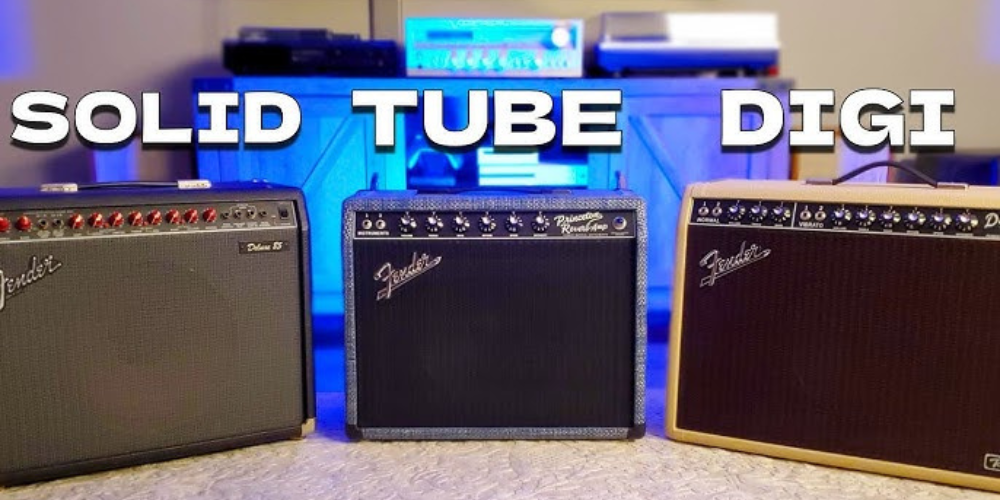Whether you’re a budding guitarist or a seasoned performer, the amplifier you choose has a massive impact on your sound, playing experience, and creative expression. With so many amp types available, how do you decide between a solid state, modelling, or tube amplifier?
Each type has its own advantages, unique tonal characteristics, and practical benefits. Understanding these differences can help you avoid costly mistakes and find the perfect amp for your personal tone goals and performance needs.
If you’re shopping in Malaysia or exploring gear online, Guitarlicious offers a curated selection of amps suitable for home practice, recording, and live gigs. Let’s dive into what makes each amplifier type distinct, and which one might be right for you.
What Makes Solid State Amplifiers a Reliable Everyday Choice?
Solid state amplifiers use transistor-based circuitry to amplify sound, making them a modern and cost-effective solution for many players. Their reputation for durability and affordability makes them ideal for casual musicians and gigging players who want something low-maintenance.
Why guitarists love solid state amps:
-
Unbeatable reliability: Unlike tube amps, solid state amps don’t require regular maintenance. There are no fragile valves to break or replace, making them perfect for travelling musicians and classroom environments.
-
Affordability without compromise: From small practice combos to 100-watt stage amps, solid state models offer tremendous value for money. You can get clean tones and usable overdrive without spending thousands.
-
Consistent performance: These amps deliver a stable tone in all conditions, hot practice rooms, damp basements, or air-conditioned studios. They don’t “warm up” like tube amps, which means plug in and play instantly.
-
Perfect for clean tones: Genres like jazz, indie, pop, and worship music benefit from the clarity of solid state amplification.
A great example would be the Roland JC-40, known for its sparkling cleans and legendary chorus effect. To explore similar solid state amps by brand, visit the Shop by Brands page at Guitarlicious.
How Do Modelling Amplifiers Push Versatility to the Next Level?
Modelling amplifiers are essentially digital tone chameleons. They simulate the sounds of famous amps, speaker cabinets, and even microphones using digital signal processing (DSP). This lets guitarists access an entire rig’s worth of tone in one box.
Key features that make modelling amps a creative powerhouse:
-
Multiple amp simulations in one unit: From crunchy British overdrive to glassy American cleans, modelling amps let you emulate the tonal profiles of iconic amps like Fender Twins, Vox AC30s, and Mesa/Boogies.
-
Integrated effects and presets: These amps often include delay, reverb, modulation, and drive pedals, all programmable and footswitchable. This eliminates the need for a bulky pedalboard.
-
USB recording and editing: Many modern modelling amps include USB ports for direct DAW (digital audio workstation) recording, making them ideal for home producers. You can also edit tones via desktop or mobile apps.
-
Great for experimenting: Want to try fuzz, phaser, and tremolo on your solos? With a modelling amp, you can. They’re fantastic for players who want to explore sound design.
The Boss Katana 50 MkII and Line 6 Catalyst are strong contenders for players who want versatility and affordability. To see real user experiences and expert breakdowns, read the tone reviews on the Guitarlicious blog.
Why Do Tube Amplifiers Still Reign Supreme for Tone Purists?
Ask any tone snob or vintage enthusiast what they play, and you’ll likely hear one answer: tube amps. Also known as valve amplifiers, these beasts use vacuum tubes to amplify your signal, and that analogue warmth is what gives them their legendary status.
Why tube amps are still adored by professionals:
-
Dynamic response: Tube amps respond to how you play, hit the strings softly for a clean shimmer or dig in for natural, gritty breakup. This “touch sensitivity” makes the guitar feel like an extension of your hands.
-
Harmonic richness: Tubes naturally compress the sound and add pleasing harmonic overtones, resulting in a rich, 3D tone that’s hard to replicate digitally.
-
Natural overdrive: Unlike distortion pedals or DSP, tube-driven overdrive feels smooth, organic, and fluid. It blooms as you turn up the volume rather than feeling harsh or synthetic.
-
Ideal for stage and studio: Tube amps shine in mic’d settings, whether it’s for recording your blues solos or powering through a rock gig.
However, these amps are heavier, more expensive, and require regular maintenance. If you’re ready to commit, brands like Vox, Marshall, and Cort have amazing tube combos. Enhance and protect your gear with quality accessories including padded amp covers, cables, and power conditioners.
Which Amplifier is Right for You?
The ideal amp isn't just about prestige, it's about finding the right fit for your goals, setup, and music.
Choose a Solid State Amp if:
-
You’re a beginner or casual player who wants a no-fuss amp for home use.
-
You’re into clean tones or light overdrive genres like funk, reggae, or folk.
-
You need an amp that’s portable, reliable, and budget-friendly.
Choose a Modelling Amp if:
-
You love experimenting with effects and tones across multiple genres.
-
You need an all-in-one solution for practice, recording, and gigs.
-
You want built-in recording capabilities and mobile tone editing.
Choose a Tube Amp if:
-
You crave authentic analogue tone with responsive dynamics.
-
You regularly perform live or record in a professional studio.
-
You don’t mind the maintenance and investment that come with high-end gear.
Not sure which route to take? Create a wishlist and compare specs by logging in through the Guitarlicious account portal.
FAQs
1. What wattage amp should I get for home use?
For bedroom or apartment practice, 10 to 20 watts is plenty. Solid state and modelling amps in this range offer enough volume without disturbing neighbours.
2. Can I gig with a solid state amp?
Yes! Models like the Roland JC-120 and Fender Champion 100 offer ample power and clean headroom. Solid state amps are also less prone to damage on the road.
3. Are tube amps better for blues and classic rock?
Absolutely. The natural saturation and warmth of a tube amp are perfect for dynamic blues licks and crunchy classic rock riffs. Think Marshall DSL or Vox AC series.
4. Do modelling amps replace the need for pedals?
Often, yes. Most modelling amps include effects like delay, chorus, reverb, and even amp modelling presets, which makes them perfect for pedalboard-free setups.
5. Where can I buy genuine amplifiers in Malaysia?
You can find high-quality solid state, modelling, and tube amps from top global brands at Guitarlicious. They also offer expert advice, local shipping, and trusted customer support.
Final Thoughts: Find the Amplifier That Elevates Your Sound
Your amplifier is more than a speaker, it’s your voice. Whether you’re a bedroom shredder, weekend performer, or recording artist, choosing the right amp ensures your tone feels alive and inspires creativity.
Solid state amps deliver reliability and simplicity. Modelling amps offer infinite tones and modern features. Tube amps provide the soulful, dynamic touch that professionals swear by. No matter your choice, what matters most is that it suits your style, skill level, and sound.
Ready to make a sound investment? Explore premium amplifier brands on Guitarlicious, browse gear on the Shop by Brands page, learn from tone tips on the blog, and complete your setup with essential accessories. Your amp journey starts now, so plug in, turn up, and play with confidence.

